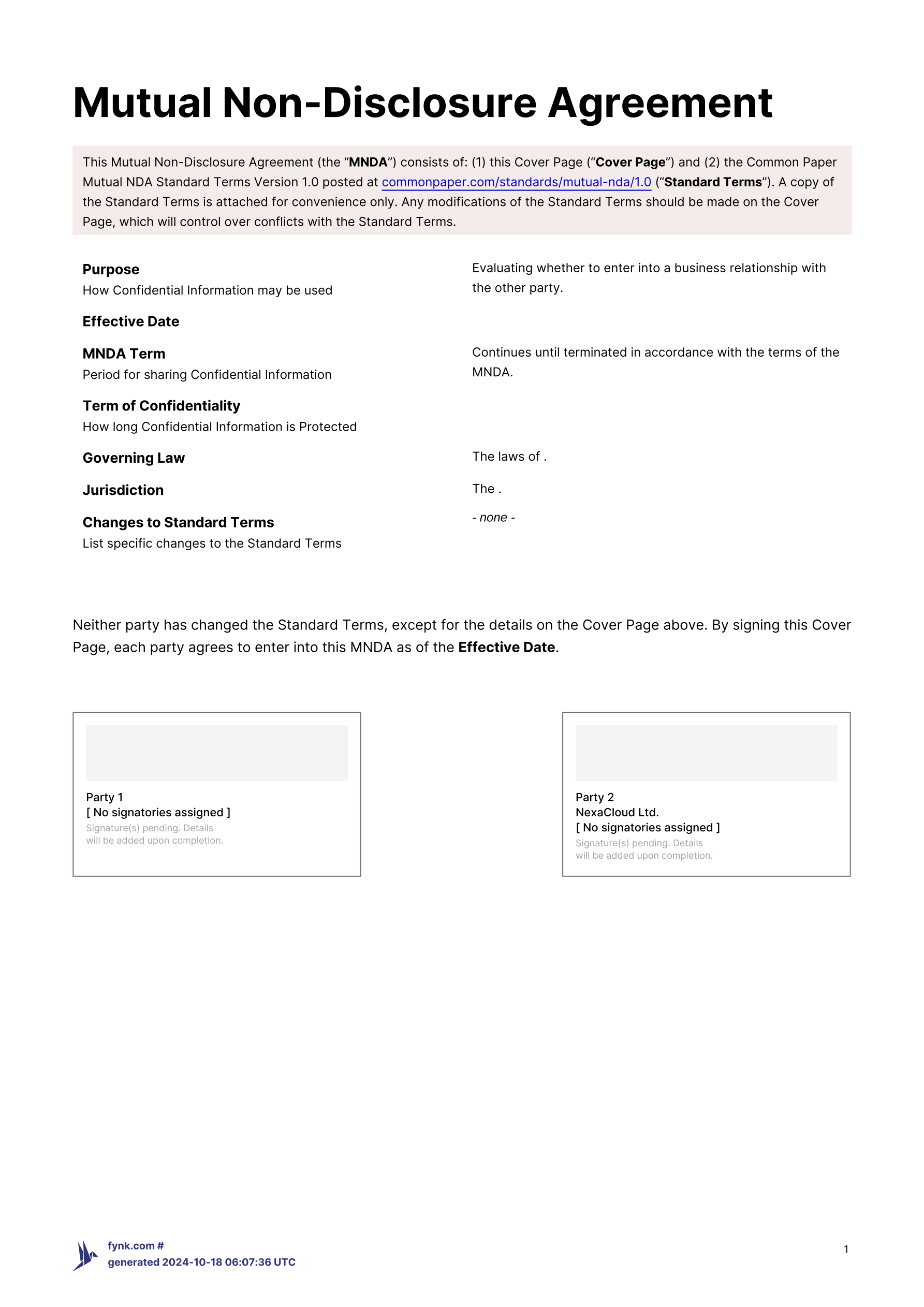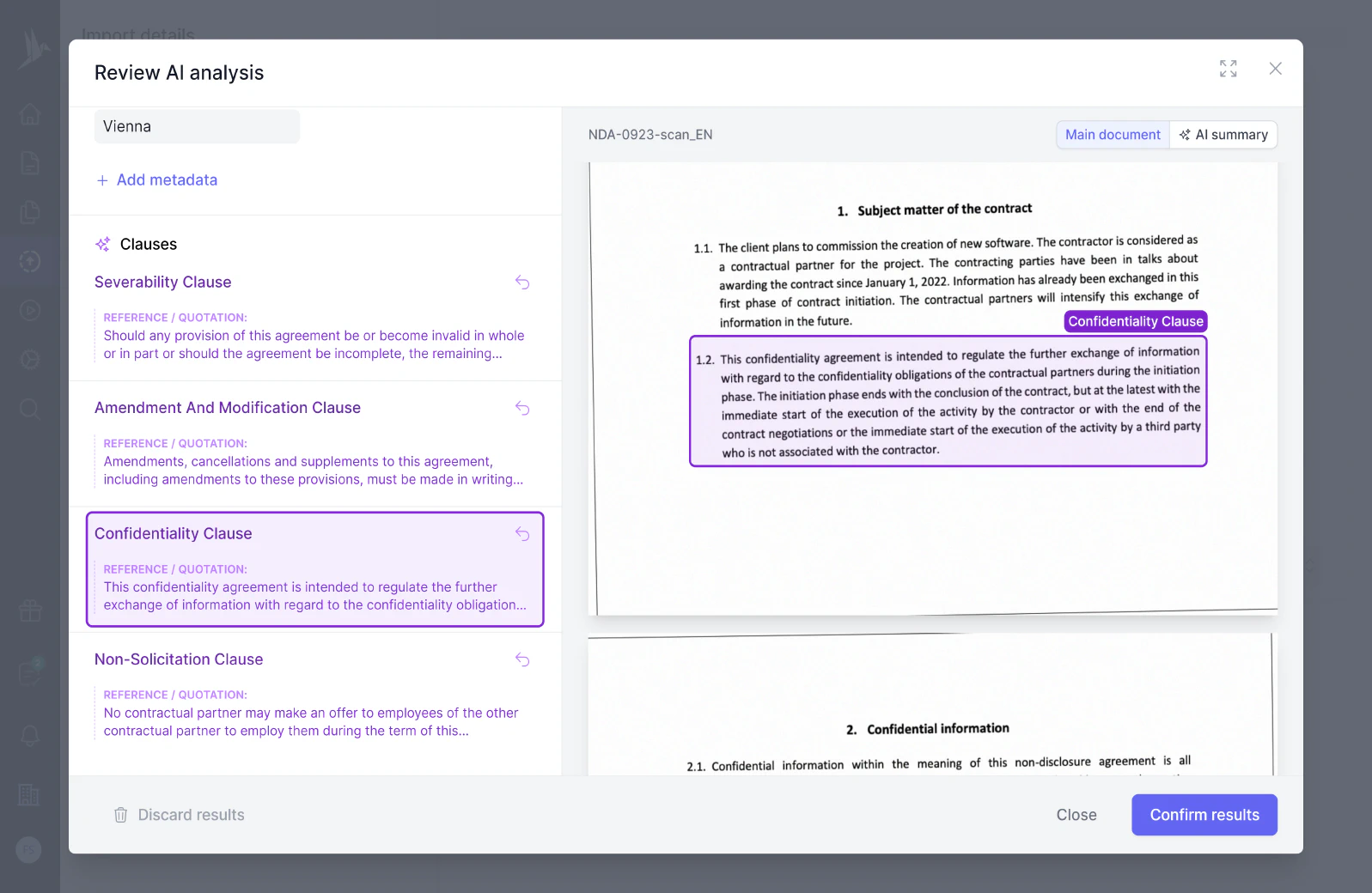
Mutual Non-Disclosure Agreement (NDA) Template
The Mutual Non-Disclosure Agreement (NDA) is a legal document that outlines the terms and conditions of a confidentiality agreement between two parties.
The "Exclusions From Confidential Information" clause outlines specific categories of information that are not considered confidential under the terms of the agreement. Typically, these exclusions include information that is publicly known, already known by the receiving party prior to disclosure, independently developed by the receiving party, or disclosed by a third party without breach of any confidentiality obligation.
Exclusions from Confidential Information. As used in this Agreement, the term ‘Confidential Information’ shall not include any information that: (i) now or hereafter becomes, through no breach by or on behalf of the receiving Party of its confidentiality obligations hereunder, generally known or available to the public; (ii) was known to the receiving Party, by lawful means, at the time the receiving Party receives the same from the disclosing Party; (iii) was furnished to the receiving Party by a third party not in breach of an obligation of confidentiality owed to the disclosing Party with respect thereto; or (iv) was independently developed by the receiving Party without use of or access or reference to the disclosing Party’s Confidential Information.
Exclusions from Confidential Information. Confidential information shall not include the following: (a) information that, at the time of disclosure, is in the public domain; (b) information that, after disclosure, is published or otherwise becomes part of the public domain through no fault of the recipient; (c) information that the recipient can show already was in the possession of the recipient at the time of disclosure; (d) information that the recipient can show was received by it after the time of disclosure, from a third party who was under no obligation of confidence to the disclosing Party at the time of disclosure.
Exclusions from Confidential Information. the term “Confidential Information” as used in this Agreement shall not include information that: (a) at the time of disclosure is, or thereafter becomes, generally available to and known by the public other than as a result of any breach of this Agreement by Prospective Purchaser; (b) at the time of disclosure is, or thereafter becomes, available to Prospective Purchaser on a non-confidential basis from a third-party source, provided that such third-party is not and was not, to Prospective Purchaser’s knowledge, prohibited from disclosing the information to Prospective Purchaser by any legal, fiduciary or contractual obligation; (c) was known by or in the possession of Prospective Purchaser prior to being disclosed by or on behalf of the Ionis Parties pursuant to this Agreement; (d) was independently developed by Prospective Purchaser without reference to or use of, in whole or in part, any Confidential Information; or (e) Ionis has agreed in writing is free of such obligations.
“Exclusions From Confidential Information” refers to specific categories or types of information that are not considered confidential under a confidentiality agreement or non-disclosure agreement (NDA). These exclusions are outlined to clarify which information the receiving party can use or disclose without breaching the agreement.
Typically, exclusions include information that:
You should use “Exclusions From Confidential Information” in agreements when there is a need to protect sensitive information shared between parties while clearly defining what information is not subject to confidentiality restrictions. This is crucial in:
Inclusion of these clauses helps prevent disputes over information that should not be kept confidential and provides clear guidelines on information use.
When drafting “Exclusions From Confidential Information,” clarity and precision are key. Here’s a structured approach:
Introduction: Clearly state that the information mentioned will not be considered confidential.
List the exclusions: Enumerate specific categories of information with clear definitions. Common exclusions include:
Provide specific examples if necessary to enhance clarity.
Conditions or limitations: Include any conditions or additional considerations, such as ensuring that the independently developed information must not use any confidential information.
Here is an example template:
“Notwithstanding anything else in this Agreement, the obligations of confidentiality shall not apply to any information that:
a) is or becomes publicly known through no fault of the Receiving Party;
b) is already known to the Receiving Party prior to disclosure by the Disclosing Party;
c) is independently developed by the Receiving Party without use of or reference to the Disclosing Party’s Confidential Information; or
d) is lawfully received from a third party without restriction on disclosure.”
“Exclusions From Confidential Information” clauses are common in contracts where sensitive information could be shared and there’s a need to delineate what should remain confidential. Such contracts include:
Non-Disclosure Agreements (NDAs)
Business Contracts
Technology and Licensing Agreements
Employment Contracts
Consulting Agreements
In these contracts, excluding certain categories of information from confidentiality can help maintain clarity in business relationships and mitigate risks of misunderstandings or legal disputes.
These templates contain the clause you just read about.

The Mutual Non-Disclosure Agreement (NDA) is a legal document that outlines the terms and conditions of a confidentiality agreement between two parties.
Dive deeper into the world of clauses and learn more about these other clauses that are used in real contracts.
An exclusive supply clause legally binds a supplier to provide goods or services solely to one buyer, prohibiting the supplier from selling to other parties. This arrangement often ensures consistent supply for the buyer, while potentially limiting the supplier's market reach.
The "Exclusive Use" clause grants one party the sole right to utilize or benefit from a particular asset, property, or service, thereby restricting others from doing the same. This provision ensures that the party with the exclusive rights has priority access without interference from competitors or other parties.
An exclusivity clause is a contractual provision that restricts one party from engaging in certain activities or dealings with other parties outside the agreement. Typically used to secure a commitment, it ensures that the party provides services, products, or rights solely to the other contracting party, often to maintain competitive advantage or preserve confidentiality.
Try our AI contract analysis and extract important clauses and information from existing contracts.
< <
Fill out the form and we will get in touch with you to give you a personal, customized demo of fynk.
Greetings!
I'm Markus, co-founder of fynk. After you've submitted the form, I'll swiftly get in touch with you.
Also, right after you submit your details, you can pick a time that works best for you for our meeting.

